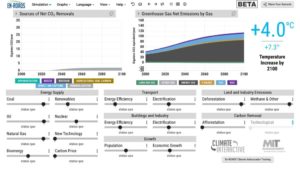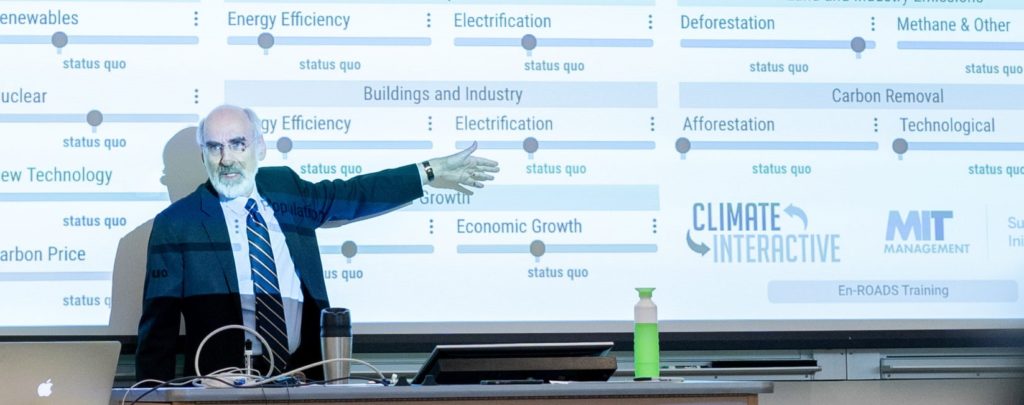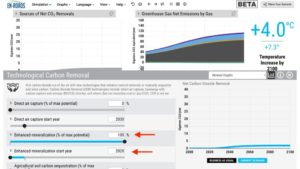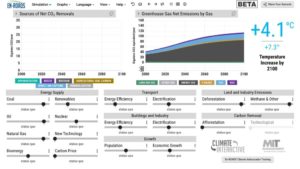MIT’s New En-ROADS Simulator Gives Insight on the Impact of Remineralization on Climate
Dr. John Sterman presenting the En-ROADS Simulator.
Rock weathering removes carbon dioxide from the atmosphere, and remineralizing the soil with silicate rock dust can speed this process up, but just how much of an impact can enhanced rock weathering have on global climate change?
To better understand the magnitude of the impact that remineralization could have on global climate change, we can turn to the En-ROADS simulator, developed by Climate Interactive, Ventana Systems, and MIT Sloan1. En-ROADS allows users to test scenarios that include changes in taxes, subsidies, economic growth, energy efficiency, energy sources, technological innovation, and carbon dioxide removal and visualize impacts on global carbon emissions and temperature1. (Check it out here!)
A recent article published in Nature found that to sequester 0.5 Gt CO2 per year, it would be necessary to apply rock dust to about 10% of agricultural land in China, USA, India, Brazil, Indonesia, Canada, Mexico, and Europe. If, instead, the goal is to sequester 2 Gt CO2 per year, approximately half of the cropland would need to be treated with rock dust1. If maintained for fifty years, this would sequester up to 100 Gt CO2 or 12% of the remaining cumulative carbon emissions that can be released while still giving us a 66% probability of limiting to below 2 oC above the pre-industrial average2.
With the En-ROADS simulator, under the detailed settings for technological carbon removal, it is possible to test out the impact of enhanced mineralization. Setting enhanced mineralization to 100% of its potential beginning immediately, the simulator, based on the best available science, shows that 2.3 Gt CO2 can be sequestered per year by the end of the century and that this would reduce warming from 4.1 oC to 4.0 oC over the same time frame. Watch this short video to see Andrew Jones of Climate Interactive explain more about enhanced rock weathering in the En-ROADS simulator.

Results of the simulation with remineralization included, with no other changes. (Click to enlarge.)
From all of this, it may seem like soil remineralization will not have much impact on global climate change, but as the Nature article points out, enhanced rock weathering is a strategy that could be implemented at large scale relatively quickly and can supplement other carbon dioxide removal techniques2. Furthermore, the study found that the three countries with the highest carbon dioxide removal potential are also the three largest fossil fuel CO2 emitters: China, USA, and India2. Also, many countries may be able to make substantial progress toward meeting their Nationally Determined Contributions (NDCs) for emissions reductions under the Paris Agreement.
Many countries are not on track to meet their pledged 2030 NDCs, but with enhanced rock weathering, China could meet 5% to 10% of its 2030 NDCs, India could meet 40%, and Brazil up to 100%2. Thus, although soil remineralization, on its own, will not be sufficient to avoid catastrophic climate change, it can play an important role as part of a more comprehensive strategy for emissions reductions.
Emma Cutler holds a PhD in engineering sciences from Dartmouth College and a BA in math and environmental studies from Bowdoin College. Currently working on flood vulnerability assessments in the Great Lakes, she has experience in systems modeling for climate adaptation and studied sustainable agriculture movements in Sri Lanka as a Fulbright research student. She is passionate about translating science to non-technical audiences and incorporating science into decision making for climate action.
References
- Climate Interactive. En-ROADS: Climate Change Solutions Simulator (2020). https://www.climateinteractive.org/tools/en-roads/
- Beerling, D.J., Kantzas, E.P., Lomas, M.R. et al. Potential for large-scale CO2 removal via enhanced rock weathering with croplands. Nature 583, 242–248 (2020). https://doi.org/10.1038/s41586-020-2448-9
- Simulating Enhanced Rock Weathering in En-ROADS. Climate Interactive (2020). https://www.youtube.com/watch?v=J9c26wPTQl8
Support us on Patreon
Thank you for joining us today! Please become a member of RTE and support us on Patreon. Unlike many larger organizations, we work with a team of determined and passionate volunteers to get our message out. We aim to continue to increase the awareness of remineralization to initiate projects across the globe that remineralize soils, grow nutrient dense food, regenerate our forests’ and stabilize the climate – with your help! If you can, please support us on a monthly basis from just $2, rest assured that you are making a big impact every single month in support of our mission. Thank you!










Got something to say?